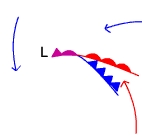Occluded StageBeing more dense, the air behind the cold front can "bulldoze" the warmer and less dense air out of the way. The advancing warm air along the warm front cannot push the colder air in its path out of the way. Instead, the warm air rises off the surface and glides up and over the colder more dense air ahead of the warm front. As a result, there is less horizontal displacement and the warm front moves slower across the earth than does a cold front. Over time the cold front catches up with the warm front and the cyclone starts to occlude (purple symbol on Figure 8.12). Click Figure.12 to see the life-cycle of a wave cyclone from the initial (cyclogenesis) to occluded stage. Link here to an animated profile view of the occlusion process. Dissolving StageThe system enters the dissolving stage after it occludes and the lifting mechanism is cutoff. Without the convergence and uplift, the cyclone dissipates in the atmosphere. Figure 8.13 Dissolving Stage
|

